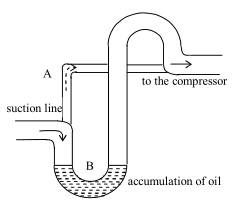问答题
6分
The engine is cooled by a closed fresh water circuit, divided into a high temperature circuit (HT) a...
The engine is cooled by a closed fresh water circuit, divided into a high temperature circuit (HT) and a
low temperature circuit (LT). The fresh water is cooled by a separate central cooler.
The cooling water in the HT circuit cools the cylinder liners, cylinder heads and turbocharger. From
the pump water is supplied to the engine manifold which is cast in the engine block. From the manifold the
water is distributed to all cylinder liner sections and from each liner upwards through the cooling water
channels in the liner collars, hence further into the cylinder heads. In the cylinder head the water is forced
by an intermediate deck to flow along the flame plate, around the valves to the exhaust valve seats and up
along the fuel injector sleeve. From the cylinder head the water is discharged via a connection piece into
the discharge manifold.
Parallel to the flow to the cylinders part of the engine water flows through the turbocharger.
The return water from the cylinder heads and turbocharger is supplied to the HT air cooler, and then
back to the inter-cooler.
In the first stage of this cooler, most of the heat from the charge air is extracted.
The LT circuit water cools the charge air in the second stage and the HT cooling water in the
intercooler. The necessary cooling for the LT water is gained from a central cooler. By controlling the LT
water temperature to the inter-cooler the correct charge air temperature can be obtained.
The HT cooling water system has to work on an over pressure of 3 bar and the LT cooling water
system on 0.7 ~ 1.5 bar over pressure.
For preheating purposes, a heater circuit with a pump and heater is connected in the HT circuit before
the engine. The non-return valves in the circuit force the water to flow in the correct direction. Before
starting, the HT circuit is heated till about 60℃ by a separate heater. The pre-heating of the engine is, prior
of starting up and loading on HFO, of utmost importance.
low temperature circuit (LT). The fresh water is cooled by a separate central cooler.
The cooling water in the HT circuit cools the cylinder liners, cylinder heads and turbocharger. From
the pump water is supplied to the engine manifold which is cast in the engine block. From the manifold the
water is distributed to all cylinder liner sections and from each liner upwards through the cooling water
channels in the liner collars, hence further into the cylinder heads. In the cylinder head the water is forced
by an intermediate deck to flow along the flame plate, around the valves to the exhaust valve seats and up
along the fuel injector sleeve. From the cylinder head the water is discharged via a connection piece into
the discharge manifold.
Parallel to the flow to the cylinders part of the engine water flows through the turbocharger.
The return water from the cylinder heads and turbocharger is supplied to the HT air cooler, and then
back to the inter-cooler.
In the first stage of this cooler, most of the heat from the charge air is extracted.
The LT circuit water cools the charge air in the second stage and the HT cooling water in the
intercooler. The necessary cooling for the LT water is gained from a central cooler. By controlling the LT
water temperature to the inter-cooler the correct charge air temperature can be obtained.
The HT cooling water system has to work on an over pressure of 3 bar and the LT cooling water
system on 0.7 ~ 1.5 bar over pressure.
For preheating purposes, a heater circuit with a pump and heater is connected in the HT circuit before
the engine. The non-return valves in the circuit force the water to flow in the correct direction. Before
starting, the HT circuit is heated till about 60℃ by a separate heater. The pre-heating of the engine is, prior
of starting up and loading on HFO, of utmost importance.
参考解析:
1. What kind of fresh water cooling system is talked about?
A. High temperature cooling system
B. Low temperature cooling system
C. Open cooling system
D. Closed central cooling system
2. Which one is cooled in both the HT and the LT?
A. Turbocharger.
B. The cylinder heads.
C. The charge air.
D. Exhaust valve seats.
3. The fresh water for the HT is cooled in _____.
A. inter-cooler
B. central cooler
C. The first stage of the LT
D. the sea water
4. How many items are cooled in the HT?
A. 4
B. 6
C. 8
D. 3


 百度扫一扫练题
百度扫一扫练题
 关注千题库公众号
关注千题库公众号








